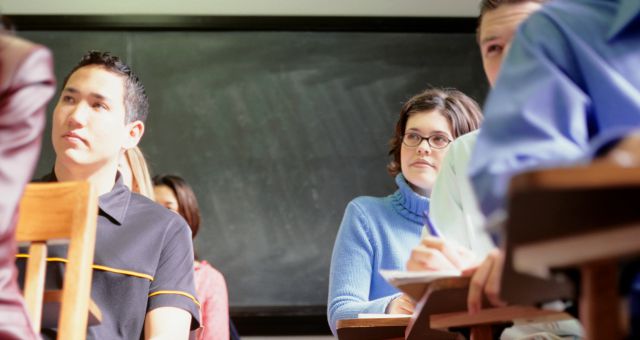Scenario-based learning can be an effective way for students to apply what they have learned to realistic situations. There are many different ways to design scenarios for online delivery, from text-based case studies to interactive, immersive simulations. Regardless of the resources that you have available, there are effective ways to put students in scenarios that contribute to their learning.
Read more ›CURRENT ARTICLE • September 24
OTHER RECENT ARTICLES
Here’s a strategy you can tuck in your folder of good ideas: a survey tool for assessing student expectations for the course. The survey’s designers believe that knowing what students expect is helpful. They also cite research documenting that discrepancies between teacher and student expectations often exist. So they compiled a short survey that asks students what technology they’re expecting in the course, what learning activities they’re anticipating, what they’re thinking they’ll be graded on, their expectations regarding faculty-student interactions, and how soon they’re expecting faculty to answer emails, post grades, and/or return assignments and be available to meet with them. Here’s a link to the survey: http://bit.ly/1EXVUAi. (Editor's Note: This link is no longer active). Surveys like these are great idea generators. What course expectations do you and your students have?
Read More › It’s good to regularly review the advantages and disadvantages of the most commonly used test questions and the test banks that now frequently provide them.
It’s good to regularly review the advantages and disadvantages of the most commonly used test questions and the test banks that now frequently provide them.
 Enter the term “group work” into a Google search, and you’ll find yourself bombarded with dozens of hits clustered around definitions of group work, benefits of group work, and educational theories underpinning group work. If you dig a little deeper into the search results, however, you’ll find that not all of the pages displayed under the moniker of “group work” describe the same thing. Instead, dozens of varieties of group learning appear. They all share the common feature of having students work together, but they have different philosophies, features, and approaches to the group task.
Enter the term “group work” into a Google search, and you’ll find yourself bombarded with dozens of hits clustered around definitions of group work, benefits of group work, and educational theories underpinning group work. If you dig a little deeper into the search results, however, you’ll find that not all of the pages displayed under the moniker of “group work” describe the same thing. Instead, dozens of varieties of group learning appear. They all share the common feature of having students work together, but they have different philosophies, features, and approaches to the group task.
Instructional strategies acquire names, labels that describe what the strategy involves—active learning, problem-based learning, cooperative learning. Sometimes the strategies gain popularity. They become widely used, and so do the terms that describe them. After a while teachers stop describing what they are doing in class. They simply refer to it by the label: “Yes, I have students work in groups. I use cooperative learning.”
Read More ›"How are you enjoying retirement, Tom?” This is the question I get everywhere I meet old friends and colleagues. “I read that nice article about your retirement in the local paper and see that the mayor even declared in a proclamation that this event was to be honored in the city as ‘Dr. Thomas R. McDaniel Day,’ and I see that the governor awarded you the Order of the Silver Crescent for your contributions to the state and region—very cool way to go out.”
Read More ›Recent research verifies that when looking at small differences in student ratings, faculty and administrators (in this case, department chairs) draw unwarranted conclusions. That’s a problem when ratings are used in decision-making processes regarding hiring, reappointment, tenure, promotion, merit increases, and teaching awards. It’s another chapter in the long, sad story of how research on student ratings has yet to be implemented in practice at most places, but that’s a book, not a blog post. Here, my goal is to offer some reminders and suggestions for when we look at our own ratings.
Read More ›It’s a gradual process, but at some point, if we’re not careful, all the courses, students, and semesters begin to add up and slowly erode our enthusiasm for the classroom. We become physically and emotionally spent, our teaching grows tired.
Read More ›There is a discourse of deficiency around students—what they can’t do, how “ill prepared” they are—that gets aired at nearly every faculty meeting. We read it in op-eds online. We hear it in state legislatures and in copier rooms. It is the air we breathe, especially if we teach in community colleges. Certain populations of students are considered more deficient than others. These populations are partitioned by institution type and placement level, rather than by race or class. Community college students and students who have landed in developmental classes are considered the most deficient of all. We blame the high schools they came from and, sometimes implicitly, we blame them. They are lazy. They need handholding. They simply don’t have the skills. There is only so much we can do with them.
Read More › Advances in neuroscience and digital imaging give us an unprecedented understanding of how individuals access, process, and respond to information. Previously we may have had an intuitive understanding that our students learned differently. Now functional MRI scans demonstrate this in living color. However, simply recognizing learner diversity is one thing; navigating this challenge in the classroom is quite another. How can we possibly hope to present content, structure learning experiences, and devise assessments that will be appropriate and effective for students with different learning strengths and challenges? Fortunately, researchers have developed a framework based in neuroscience that can help.
Advances in neuroscience and digital imaging give us an unprecedented understanding of how individuals access, process, and respond to information. Previously we may have had an intuitive understanding that our students learned differently. Now functional MRI scans demonstrate this in living color. However, simply recognizing learner diversity is one thing; navigating this challenge in the classroom is quite another. How can we possibly hope to present content, structure learning experiences, and devise assessments that will be appropriate and effective for students with different learning strengths and challenges? Fortunately, researchers have developed a framework based in neuroscience that can help.







